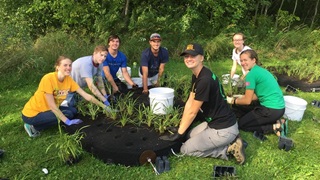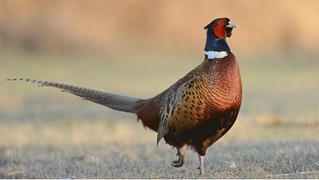Getting ducks in a row: Restoring critical habitat for waterfowl in North Dakota
Ducks Unlimited helping to convert marginal cropland back to native prairie habitat
In a landscape pocked with hundreds of marshes, a raft of northern pintails floats in a placid pool, submerging their black bills and pointing brown tail feathers toward the sky.
Nearby, hens nest in the grass, waiting for their eggs to hatch during their summer stopover in the upper Midwest.
A mix of wetland and grassland, this landscape is part of the Prairie Pothole Region, which provides critical nesting habitat for migratory waterfowl in North America.
“You could have 80 or more pairs of breeding ducks that’ll settle in a given square mile in that watershed,” says Jonas Davis, manager of conservation programs for Ducks Unlimited in North Dakota.
The wetlands also retain water, acting like a sponge to relieve flooding. They reduce soil erosion, and they improve water quality by preventing sediment from running off into the lakes.
There’s another thing native prairie is noted for—being converted to cropland.
The Devils Lake watershed in North Dakota, part of the Prairie Pothole Region, has “fertile soil for farming, and has a long tradition there,” says Davis, noting that when the landscape is converted to farmland, the change introduces problems like soil erosion, flooding, and soil and water quality, in addition to the loss of habitat.
Over the past two years, declining commodity prices have caused a growing interest among farmers and landowners in restoring some of their marginal cropland to native grassland and wetlands that can still be used for haying and grazing.
A few nationally-funded programs, like the U.S. Department of Agriculture’s Conservation Reserve Program, have provided an option for landowners to revert their land to its native condition.
“However, CRP is currently underfunded and oversubscribed,” Davis says.
In North Dakota, Ducks Unlimited saw the opportunity to help. The organization knew landowners were interested in restoring their land; they just needed the funds to do it.
Supported by a $100,000 Ecofootprint grant from Enbridge, DU raised about $300,000 to incentivize landowners to restore and enhance 640 acres of habitat in the Devils Lake Basin.
“The Enbridge grant came at a good time. We can go back to landowners and tell them that we have funds through Enbridge that will help them restore and enhance the habitat . . . and improve the land for wildlife, will still being a part of a landowner’s farming operation,” Davis says.
Landowners who volunteer to join the program will receive cost-share to restore native grasses and impaired wetlands on their property. The grant will also cover part of a plan to help farmers use the restored land for cattle grazing, and the cost of any necessary fencing and watering systems.
The majority of the project will take place next spring, but “a few landowners have already signed on,” notes Cindy Finch, Enbridge’s senior public affairs advisor based in Duluth, MN.
DU has received support through Enbridge’s Ecofootprint Grant Program for three separate projects in 2016.
Enbridge also provided $24,740 to help educate future wildlife biologists and the public about the Prairie Pothole Region, and $50,000 to study the relationship between waterfowl conservation and the energy development industry.
Says Davis: “Providing nesting habitat for ducks is the primary goal—and a critical need from a continental perspective.”










